There are few questions more important for the 21st century than how we will power our electric grids. Literally trillions of dollars are at stake, and possibly even the future of the planet. While future electricity generation will likely include natural gas and nuclear, it’s a good bet that wind and solar will inevitably make up the majority of the future grid. Both require no fuel and, therefore, cost almost nothing to operate. Both produce virtually no environmental wastes. Both are cost-competitive with coal, nuclear and natural gas today, and both will see their costs continue to drop even further. Even without subsidies, clean energy alternatives are becoming the clear cost leaders on the grid.
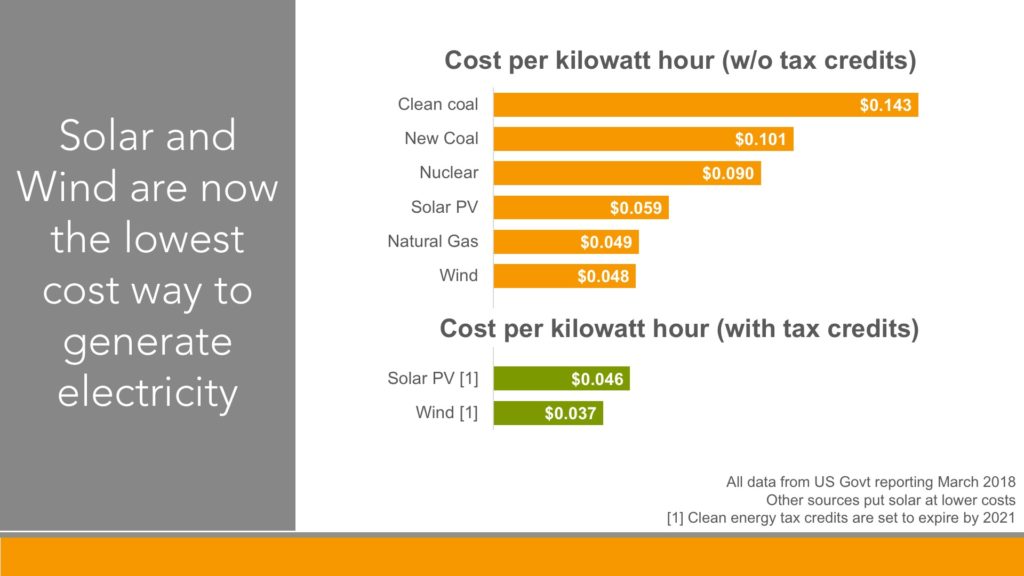
But, wind and solar are not the same. Wind turbines benefit from economies of scale. As they get bigger, their costs go down – but only up to a point. Similar to coal and nuclear plants in the last century, the complexity of giant machines overcomes scale. Cost savings slow down and disappear. By comparison, solar’s cost declines are driven by economies of volume – the more you make of something, the cheaper it gets. This means that solar costs will decline from both increasingly larger solar farms, as well as deployments that are smaller, simpler, and far, far more numerous.
GET MONTHLY NEWS & ANALYSIS
Unsubscribe anytime. We will never sell your email or spam you.
As I’ve gone through the math and the science of various energy sources, a future powered largely by solar is starting to look like an inevitability.
How can solar keep getting cheaper?
The amazing growth in global solar deployments over the last 40 years is matched only by the even more jaw-dropping declines in costs.
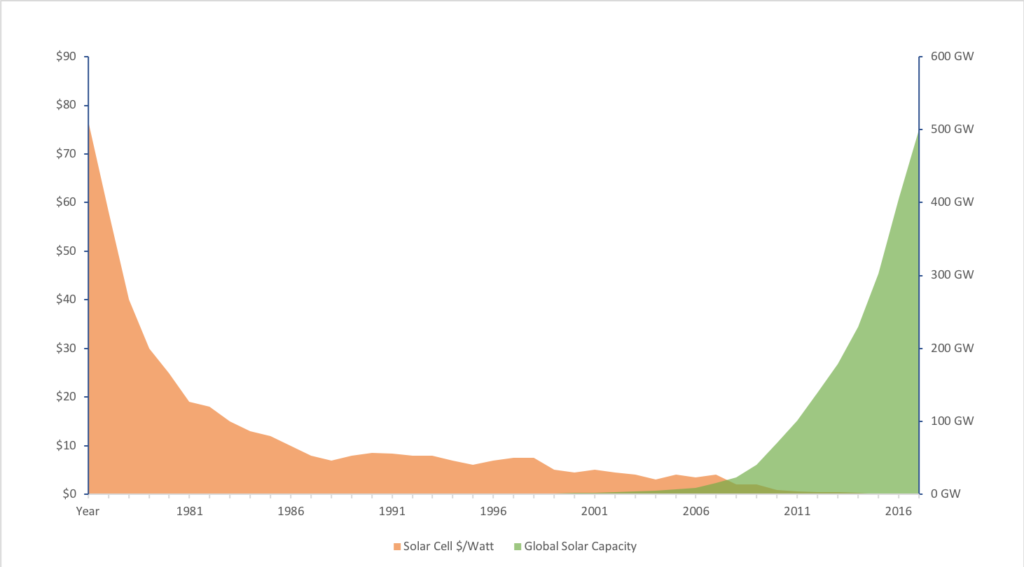
There are four trends driving the cost of solar lower.
#1 – Solar is a technology, not a fuel
Fuels like coal, natural gas and uranium are finite. Automation and new techniques help lower the cost of extracting these fuels, but it is inevitable that these fuels will get more expensive in the long term as we have to work ever harder to find more.
By contrast, solar requires no fuel. Once in place, a solar array will just sit there for decades, generating electricity at almost no additional cost. As a technology, solar benefits from cost reductions that no fuel-based power plant can match. The more solar panels you make, the cheaper they get.
#2 – Solar can piggyback existing investments to lower costs
You can’t stick a coal plant on the roof of a building. Nuclear reactors won’t work in a parking lot. But, with solar, you can generate electricity on top of pretty much anything.
Solar panels obviously sit on roofs but they can also go places not suited for other types of electric generation. They can be built over parking lots so no new land needs to be purchased. Solar canopies not only protect cars from direct sunlight, but the electricity can also be used to charge electric vehicles. Solar farms can be built on top of “brownfield” locations like old landfills that have no other commercial use. Water reservoirs can be covered with solar panels to reduce evaporation. Some people are even experimenting with solar roadways that use specialty solar cells instead of asphalt.
The most unique and exciting solar piggybacking is Building Integrated Photovoltaics (BIPV). This includes solar windows, solar paint and the most promising of all, solar shingles. Tesla didn’t invent these but they have done more than anyone to popularize the idea. Every home has a roof and most roofs must be replaced every 10-15 years. Given that 60% of roof costs are labor, even higher priced solar shingles have the potential to make solar roofs available to everyone.
#3 – Solar panels last much longer than their warranties
Solar farms are mechanically simple. Other than trackers that help solar panels follow the sun, solar has no moving parts. Solar panels last for decades. They only tend to fail because their glass covers get hazy or daily heat cycles loosen internal connections. Challenges like these are relatively easy to address and the lifecycle of panels will continue to increase.
Even though solar panels built 30 and 40 years ago continue to operate today, the cost of solar energy is calculated assuming panels will only last through their typical 20-year warranty period. If modern panels prove to actually last 40 years or longer, then all the industry’s cost calculations are twice as high as they should be. This would mean that solar is even cheaper compared to coal, nuclear and natural gas than current analysis suggest.
Here is another way to look at the impact of longer life solar panels: hundreds of gigawatts of solar energy will become effectively free in 20-25 years as all the current solar farms are paid off. This puts an entirely new meaning to Freeing Energy.
#4 – New solar technologies are constantly emerging
Solar is not sitting still. New technologies are being commercialized everywhere. Perovskite cells use lower cost materials and can be manufactured in more efficient ways. Half-cell and bi-facial panels leverage existing technology to produce more electricity per panel. The US government continues to support solar research through grants and university partnerships (for example, the Department of Energy just launched $46 million in grants to improve how solar works in existing grids).
Beyond lower costs – solar is the ultimate source of local energy
Locally generated electricity (local energy) creates a laundry list of benefits:
- Local jobs – local energy is built and operated by the people who live in the community. It’s like farm-to-table but for electrons.
- Reduced needs for transmission lines – electricity is produced near the people who use it. This avoids the incredibly expensive high voltage transmission lines that carry power across the country and can cost up to $1 million per mile.
- Reduced power losses – moving electricity between distant power plants and customers results in the loss of 6% of all electricity.
- More resilient – nearly all outages and blackouts result from broken power lines. By eliminating long-distance wires, local energy solutions like microgrids and mini-grids can keep electricity running even when the grid is offline.
- Easier to finance – smaller project sizes means less risk for banks and investors.
- Faster deployments – many smaller projects can be deployed at the same time, and all of them can be much faster than traditional large power plants.
No other source of electricity is better suited for local energy. A solar farm can scale up to have as much power as a nuclear plant. But, it can also be small enough to charge a phone. No matter what size project is required, solar is likely to be one of the most economic options. Residential rooftops, commercial building rooftops, microgrids, mini-grids, campuses, and community solar gardens are all great examples of solar’s unique flexibility in scaling.
There are other local energy generation options but each has limitations that will limit their market size. Micro-hydro, wave energy, and geothermal only work in specific geographies. Similarly, natural gas turbines must be situated near pipelines. Small wind turbines only make sense where wind is unusually strong and low to the ground. Diesel and propane generators require ongoing access to fuel and are only well suited for backup power. Small modular nuclear reactors (SMRs) are a decade from being commercialized and even then, most communities will resist them.
Getting past intermittency
The Achilles heel of solar energy is intermittency – the highly predictable day and night cycle as well the unpredictable patterns of weather. The challenge of intermittency can be broken into three buckets: daily, weekly and seasonally.
Daily changes like clouds, rain and, of course, nighttime, can be handled by batteries. Like solar, the cost of batteries is declining rapidly. We are already at a point where solar is less than grid-delivered electricity. And we are only a few years away from battery prices dropping to the point where we can power an entire day and night with stored solar power and still cost less than the grid.
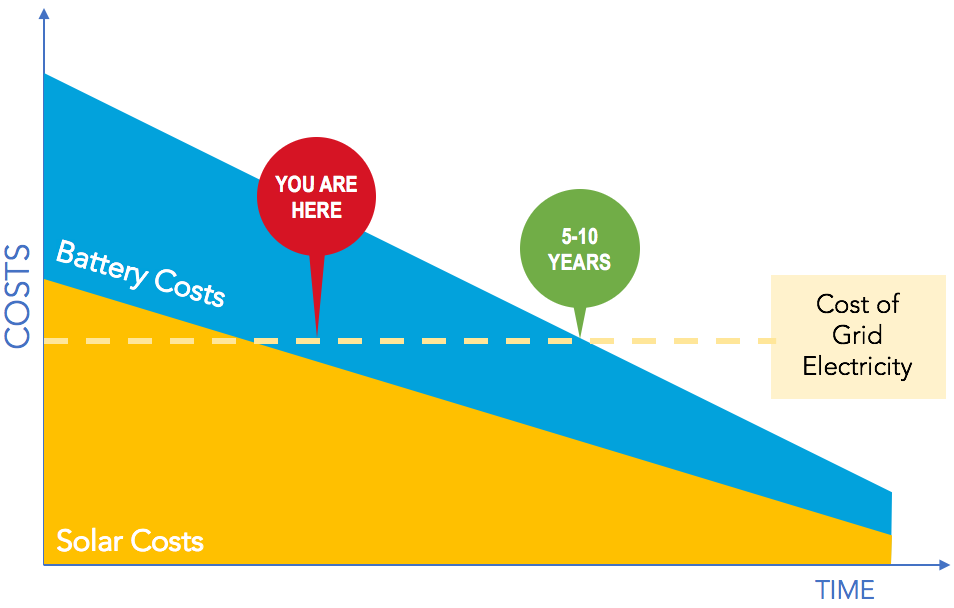
A lot more battery power is required to store solar during week-long inclement weather. Over time, declining prices will make batteries cost-effective. But until then, natural gas is the ideal complement to solar (and intermittent wind). Natural gas turbines are very low cost and can be spun up quickly to compensate minute to minute when solar is not available.
It turns out that another megatrend may be just the solution solar needs for daily and weekly storage – Electric Vehicles (EV). The average EV has enough storage to power the average home for several nights. As EV’s move into the mainstream, the aggregate battery storage may well be enough to handle virtually all the day-to-day and week-to-week intermittency challenges of a solar-powered (and wind-powered) grid.
The remaining challenge for solar’s adoption is seasonality. The further you get from the equator, the shorter winter days become. If you build a solar farm and battery plant large enough to power your community during the summer months, it may only have half the required power during short winter days. The Department of Energy recently launched a competition to find solutions for “long-term storage” and there are many promising technologies on the horizon. I will cover long-term storage in an upcoming article.
The Freeing Energy Perspective
Solar is on its way to becoming the least expensive way to generate electricity. With batteries plummeting in price and EVs becoming mainstream, it will only be a few years before we can store excess solar power and compensate for any normal levels of intermittency. There are so many trends and technologies in its favor, it seems just about inevitable that solar will emerge as the predominant source of electricity on the grid in the next 10-20 years.
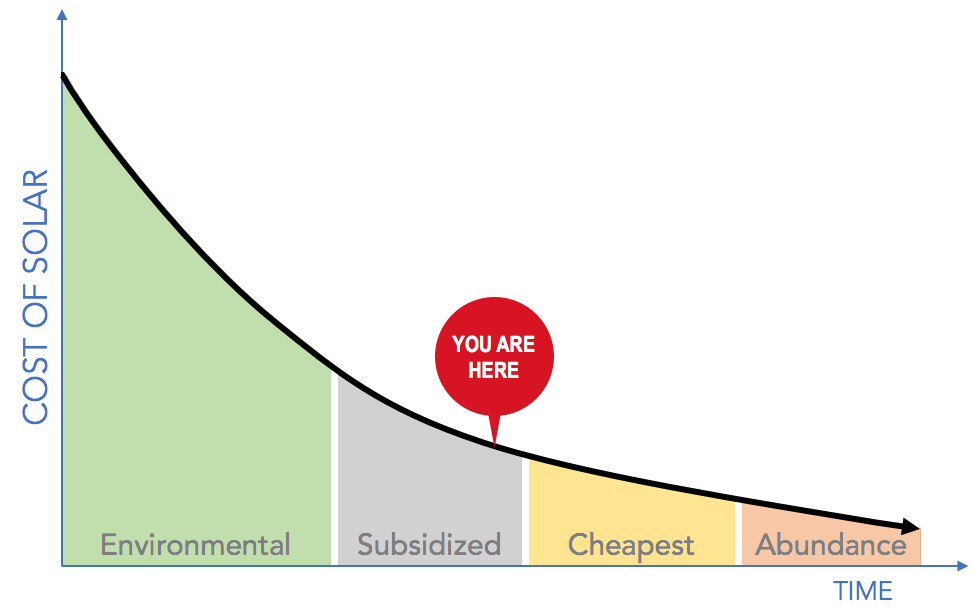
If you’ve made it this far through the article, you may have noticed something missing. I purposefully left out pollution and greenhouse gases. The earliest days of the clean energy movement were entirely driven by environmental concerns. While these may well remain the most important consideration, the point of this article is that we have shifted from an environmentally driven transformation to one almost entirely dictated by economics. In fact, we are rapidly approaching a new phase for clean energy where costs drop so low that subsidies are no longer needed for it to be cost competitive. But, the cost of solar won’t stop there. It will continue dropping until it has become so inexpensive that we have, for the first time in human history, more energy than we need. Just like when data bandwidth became ubiquitous, abundant energy will spawn entirely new industries and likely prove to be one of the most exciting and disruptive forces of the 21st century.

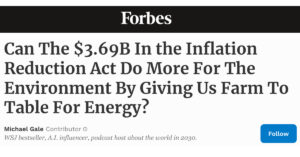

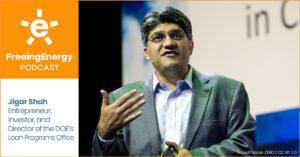
3 Responses
Regarding: #4 – New solar technologies are constantly emerging. – There will soon be a new way to configure cells in a panel and manually or automatically optimize the coupling for maximum power output. With this change, partial shading will have only a very minor effect, This opens the easements for high voltage power lines, in or near cities, as excellent sites for PV installations, that are already under the control of companies in the electricity business. Overall, this is a huge area, available for Microgrids with the generation close to the loads.
Newt, this sounds very interesting and aligns with some projects I’m involved with. Can you tell me more about this? Are there specific companies working on this?
Sorry readers, there are proprietary aspects to a detailed answer. Bill, I’ll answer by E-Mail with appropriate legend.